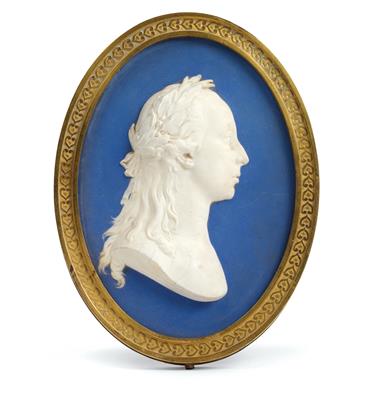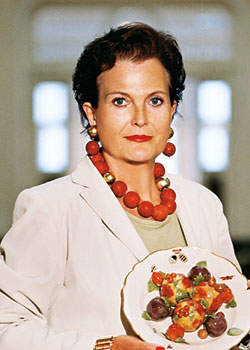A medallion with the Portrait of Emperor Franz II. (I.),

of oval form, biscuit-porcelain on blue ground, gold-plated bronze-frame and heart-shaped frieze, Height: 17,5 cm, Width: 13 cm, Vienna, Imperial Manufactory, model by Anton Grassi ca. 1800, in the Wedgwood style (Ru)
This portrait medallion is part of the statue “Großer Genius des Friedens” holding the medallion in his raised hands. The statue without the medallion was offered at the Glass & Porcelain auction on 19.4.2012, Lot 1218, at Dorotheum Vienna.
Franz II. (I.), Holy Roman Emperor, Emperor of Austria, eldest son of Emperor Leopold II. and Maria Ludovica of Bourbon-Spain, (b. Florence 12.2.1768–2.3.1835 d. Vienna), buried in the Capuchin Catacombs, Vienna. 1790, (second) marriage to his cousin Maria Theresia, (Naples 6.6.1772–13.4.1807 Vienna), daughter of King Ferdinand I., Princess of Sicily, who bore him 12 children in 17 years, d. 1807. The “Genius of Peace” was a present by Emperor Franz II., (I.) to King Ferdinand I., King of Naples Ferdinand IV.
Lit.:
J. Folnesics, Dr. E. Braun, Geschichte der K. K. Wiener Porzellan-Manufaktur, Vienna 1907, p 195ff; the previous year (1801) the emperor sent Grassi 100fl for his angel of peace.
Lit.:
W. Neuwirth, W. Mrazek, Wiener Porzellan 1718–1864, Wien MAK 1970, p 37: Anton Grassi, (Vienna 1755-31.12.1807 Vienna), from 1769 enrolled at the Academy, 1768-1774 with Franz Xaver Messerschmidt, from 1778 modeller at the Vienna Porcelain Manufactory, assisting Johann Joseph Niedermayer; working with Beyer at Schönbrunn Palace, 1784-1807 model master, 1790 member of the Vienna Academy, 1792 Italian journey, as of 1794 head of advanced categories and corrector of history- and landscape painting. Antonio Canova, Italian sculptor (Possagno 1.11.1757–13.10.1822 Venice), 1798 Vienna, commissioned by Duke Albrecht von Sachsen-Teschen with the tomb of his deceased wife Maria Christina, in St Augustin, Vienna. Anton Grassi may have been influenced by Canova's neoclassical style.
Lit.:
Museo di Capodimonte, Napoli, Civiltá dell’ Ottocento, Le arti figurative, Electa Napoli, ill. 1.1, Manufacture Imperiale de Vienna (1717–1864) Il Genio della Pace, 1800, Antonio Grassi (Vienne 1755–1807) Biscuit, rame dorato, granito, Height: 50 cm, Iscr. Sulla base di Marmo: Grassi F. AN.1800, inciso e dipinto in oro, Napoli, Museo di Capodimonte, Inv. OA 5377; After 1829 the Statue has been standing in the second antichamber of the Palazzo di Capodimonte and is currently in the Museum di Capodimonte.
Specialist: Ursula Rohringer
 Ursula Rohringer
Ursula Rohringer
+43-1-515 60-382
ursula.rohringer@dorotheum.at
18.10.2017 - 15:00
- Estimate:
-
EUR 5,000.- to EUR 9,000.-
A medallion with the Portrait of Emperor Franz II. (I.),
of oval form, biscuit-porcelain on blue ground, gold-plated bronze-frame and heart-shaped frieze, Height: 17,5 cm, Width: 13 cm, Vienna, Imperial Manufactory, model by Anton Grassi ca. 1800, in the Wedgwood style (Ru)
This portrait medallion is part of the statue “Großer Genius des Friedens” holding the medallion in his raised hands. The statue without the medallion was offered at the Glass & Porcelain auction on 19.4.2012, Lot 1218, at Dorotheum Vienna.
Franz II. (I.), Holy Roman Emperor, Emperor of Austria, eldest son of Emperor Leopold II. and Maria Ludovica of Bourbon-Spain, (b. Florence 12.2.1768–2.3.1835 d. Vienna), buried in the Capuchin Catacombs, Vienna. 1790, (second) marriage to his cousin Maria Theresia, (Naples 6.6.1772–13.4.1807 Vienna), daughter of King Ferdinand I., Princess of Sicily, who bore him 12 children in 17 years, d. 1807. The “Genius of Peace” was a present by Emperor Franz II., (I.) to King Ferdinand I., King of Naples Ferdinand IV.
Lit.:
J. Folnesics, Dr. E. Braun, Geschichte der K. K. Wiener Porzellan-Manufaktur, Vienna 1907, p 195ff; the previous year (1801) the emperor sent Grassi 100fl for his angel of peace.
Lit.:
W. Neuwirth, W. Mrazek, Wiener Porzellan 1718–1864, Wien MAK 1970, p 37: Anton Grassi, (Vienna 1755-31.12.1807 Vienna), from 1769 enrolled at the Academy, 1768-1774 with Franz Xaver Messerschmidt, from 1778 modeller at the Vienna Porcelain Manufactory, assisting Johann Joseph Niedermayer; working with Beyer at Schönbrunn Palace, 1784-1807 model master, 1790 member of the Vienna Academy, 1792 Italian journey, as of 1794 head of advanced categories and corrector of history- and landscape painting. Antonio Canova, Italian sculptor (Possagno 1.11.1757–13.10.1822 Venice), 1798 Vienna, commissioned by Duke Albrecht von Sachsen-Teschen with the tomb of his deceased wife Maria Christina, in St Augustin, Vienna. Anton Grassi may have been influenced by Canova's neoclassical style.
Lit.:
Museo di Capodimonte, Napoli, Civiltá dell’ Ottocento, Le arti figurative, Electa Napoli, ill. 1.1, Manufacture Imperiale de Vienna (1717–1864) Il Genio della Pace, 1800, Antonio Grassi (Vienne 1755–1807) Biscuit, rame dorato, granito, Height: 50 cm, Iscr. Sulla base di Marmo: Grassi F. AN.1800, inciso e dipinto in oro, Napoli, Museo di Capodimonte, Inv. OA 5377; After 1829 the Statue has been standing in the second antichamber of the Palazzo di Capodimonte and is currently in the Museum di Capodimonte.
Specialist: Ursula Rohringer
 Ursula Rohringer
Ursula Rohringer
+43-1-515 60-382
ursula.rohringer@dorotheum.at
|
Buyers hotline
Mon.-Fri.: 9.00am - 6.00pm
kundendienst@dorotheum.at +43 1 515 60 200 |
| Auction: | Works of Art - Furniture, Sculptures, Glass and Porcelain |
| Auction type: | Saleroom auction |
| Date: | 18.10.2017 - 15:00 |
| Location: | Vienna | Palais Dorotheum |
| Exhibition: | 07.10. - 18.10.2017 |
